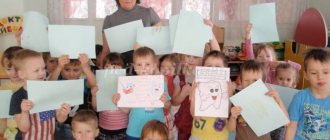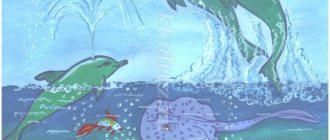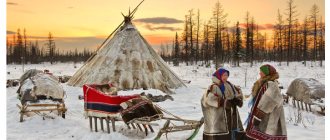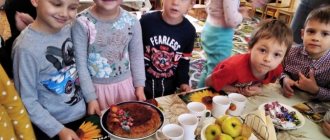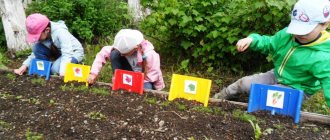Environmental project “Water is life” (senior preschool age)
Natalya Kuprina
Environmental project “Water is life” (senior preschool age)
Environmental project on the theme “
Water is life ” (
senior preschool age ) Type of project : short-term, educational and creative
Age group : senior (from September 11 to October 30)
Project participants : children, parents, teachers, swimming instructor
Relevance
Without water, life on Earth . Life arose and exists thanks to the amazing properties of water. More than 70% of the Earth's surface is covered with water. Pay attention to the fact that even such a familiar object as water is fraught with a lot of unknowns. Children need to be taught the skills of environmentally conscious attitudes in everyday life, in particular, to teach children to use water carefully and economically.
Problem
Lack of understanding among children about the importance of water in human life , about the main sources of water pollution, its consequences, measures to prevent water pollution
Objective of the project .
Expand children's knowledge about the properties of water, the importance of water in the life of all life on earth.
Project objectives .
For children:
To generalize and expand children's knowledge about the object of inanimate nature - water. Expand children's knowledge about water, its properties and conditions.
To form ideas about the importance of water in life and all life on Earth. Give an idea of the role of water in the life of humans , plants and animals.
Develop experimental skills; the ability to find ways to solve problem situations.
Enrich your vocabulary. Develop curiosity and cognitive activity
Introduce children to the values of a healthy lifestyle : the habit of washing hands, washing, tempering.
Foster a conscious, careful attitude towards water as an important natural resource. To form ideas among children that water should be conserved.
For parents:
Involving family members of pupils in the educational process; research activities with children.
Create a developing subject-spatial environment in a group on the topic “ Water ”
, supplement the experimentation corner with materials and equipment.
To promote the active involvement of parents in joint activities with the child in family and kindergarten settings.
Joint creative work of parents and children on this topic.
Project products : joint creative work of students and parents on this project (crafts, drawings, posters, presentations, etc.)
Planned results:
The desire to independently use water and learn more about it, using familiar and new methods, methods and techniques, actively using all senses: touch, vision, hearing, taste, smell, sensorimotor actions.
To formulate in children initial ideas about water as a source of life for living organisms
Replenish and expand children's knowledge about the forms and types of water: springs, rivers, seas, lakes, oceans.
Interest in experimentation.
Development of initiative, intelligence, and independence in children.
Readiness for logical cognition.
To increase the educational competence of parents in environmental education of preschool children .
Forms of project : experiments, educational activities, observations, reading fiction on the topic, conversations, work activities.
Project stages :
1. Preparatory
Selecting a topic. Statement of the problem, definition of goals and objectives. Studying methodological literature. Selection of methodological, popular science and fiction literature, illustrated, demonstration, didactic and other material on this topic. project action plan . Discussion with parents about the goals and objectives of the project , clarifying the possibilities and funds necessary to implement the project . Determining the content of activities of all project
2. Main
Contents of the teacher's activities. System of activities for children.
Cognitive activity.
•examination of illustrations from the series: “ Water , where we find it, who needs it”
;
• observing natural phenomena while walking (clouds, rain, snow)
;
•organized educational activities: “Properties of water: cold, warm, hot; liquid, solid, gaseous; without taste, color or smell." "About the benefits of water"
.
•work in nature: caring for indoor plants (timely watering)
.
Research activities.
•Conducting experiments: “ Water liquid , solid, gaseous”
;
“Water has no color, taste or smell”
;
"
Water has no form .
" “Some substances dissolve in water, some do not dissolve
.
“ Water , dissolving substances, acquires their taste, color, and smell.” “
Water can be warm , cold and hot” , etc.
Game activity.
•Didactic games: “Answer quickly”
,
“The fourth wheel”
,
“Yes - no”
,
“Good - bad”
,
the water
hidden ?” ,
“Sky, earth,
water ” ,
“Say a word”
,
“Who can collect it faster?”
.
• Moving, round dancing and finger games.
Speech activity.
•Conversations on the topics: “Autumn”
,
“What kind of
water , its properties” ,
“Where can we find water”
,
“Why do we need it”
,
“About the benefits of water”
,
“What would happen if there was no water”
,
“About caring for water”
, “
Water is needed not only by humans, but also by animals, fish, plants”, “The importance of water in
human life ” ,
“
Water around us ” ,
“Water pollution and how to avoid it”
,
“Who lives in water”
,
“Where can meet water”
,
“Save water together”
,
“What do we know about water”
,
“Natural phenomena”
, etc.
•Reading works of fiction: K. Chukovsky “Fedorino’s grief”
,
"Moidodyr"
;
P. Sinyavsky “Who doesn’t wash himself”
, T. Zhibrova
“Stream”
, G. Vieru
“How a hedgehog washes himself”
, nursery rhyme
“Washbasin”
,
“Rain, rain more”
, riddles about water.
Productive activity.
• Creative works of children and parents on this topic.
Health work.
• Wash hands, face, neck with cool water.
Working with parents:
• involvement of parents in organized educational activities with children;
• participation of parents in the creative process of the project .
3. Final stage
Creation of a card index “Experiments and experiments with water”
.
An exhibition of creative works made by parents and children.
Open display in the pool.
Presentation of the project for children , parents, teachers.
Bibliography:
Veraksa N. E., Galimov O. R. Cognitive and research activities of preschoolers , for working with children 4-7 years old. — MOSAIC-SYNTHESIS, 2014.
Shorygina T. A. Conversations about water in nature. Guidelines. – M.: TC Sfera, 2016. – 96 p.
Shorygina T. A. Conversations about natural phenomena and objects. Guidelines. – M.: TC Sfera, 2022. – 96 p.
Shorygina T. A. Educational fairy tales. Conversations with children about the Earth and its inhabitants. – M.: TC Sfera, 2016. – 80 p.
Internet resources
Educational - research project in the preparatory school group “Water is the source of life”"
Kunavina Larisa Yurievna,
MADOU "Kindergarten No. 9" Bogdanovich, Sverdlovsk region,
teacher
Cognitive and research project in the preparatory school group
“Water is the source of life”
We must remember water with a capital W, since it is not only necessary for life, it is life itself.
(Exupery)
Project theme: Water - the source of life"
Project type:
Cognitive-research, group.
Project participants
: children of the preparatory group, parents, teachers.
Duration
: medium term (3 weeks)
Relevance of the topic:
Water is one of the main resources on Earth. Water is a word we have known since birth. Sometimes we don’t even think about what it means and what it means to us. But water is the main component of all living things on our planet. Without water, no one and nothing on earth can exist. Our ancestors drank only clean, living water, and created legends and fairy tales about it. It is impossible to imagine what would happen to our planet if fresh water disappeared. But such a threat exists. There is only 3% fresh water in the world. These reserves are being depleted, and fresh water is becoming less and less. All living things around us suffer from polluted water. Therefore, water is our main wealth.
Based on the results of conversations with children, we found out that children know little about what happens to water in nature; what properties does it have; can a person and all living things live without water; how much water is on earth; how water gets into our apartments. We decided to find out how to use it carefully. For the study, we chose the topic: “Water is the source of life.”
Objective of the project:
Formation in children of knowledge about the importance of water in the life of all life on earth: water is the source of life, as well as a conscious, careful attitude towards water as an important natural resource, that is, the education of environmental consciousness.
Tasks:
To consolidate and systematize children's knowledge about water and its properties.
Introduce the water cycle in nature.
Give an idea of the role of water in human life and living organisms.
Continue to introduce children to the basic rules of hygiene and behavior on the water.
Develop children's cognitive abilities, teach them to show independence in acquiring knowledge during experiments.
To develop children's curiosity, the ability to observe, analyze, and draw conclusions.
Foster respect for water.
Formulation of the problem:
Life on earth without water is impossible. Can we live without water? Who needs water? Where do we find water in nature? What state is water in? Should we conserve water and why?
Hypothesis:
if there was no water, there would be no life on Earth.
